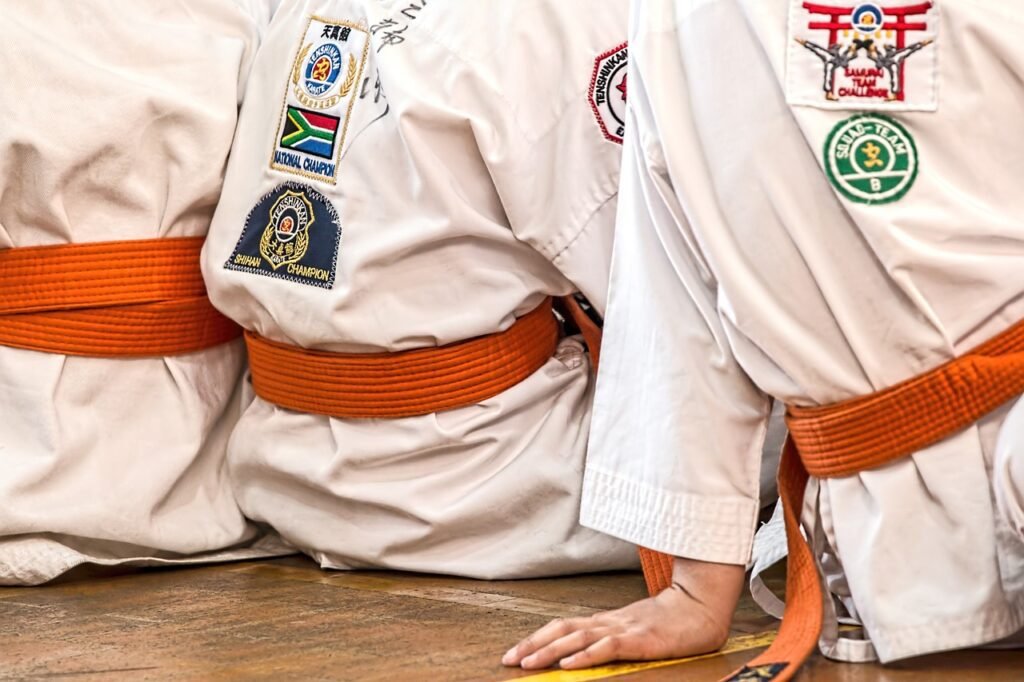Imagine you’re face to face with a master of striking techniques – someone whose punches and kicks are incredibly precise and lightning fast. It can feel intimidating, but fear not! In this article, we will explore some effective ways to counter those expert level moves and turn the tables in your favor. So, get ready to level up your defense and gain the upper hand against even the most skilled opponents.

Understanding Expert Level Striking Techniques
Expert level striking techniques are advanced methods employed by highly skilled fighters to achieve maximum effectiveness and efficiency in their strikes. To fully comprehend and effectively counter these techniques, it is crucial to recognize the different types of strikes, analyze the mechanics and principles behind expert striking, and identify common strategies used by expert strikers.
Recognizing the Different Types of Strikes
Expert level striking encompasses a wide range of strikes including punches, kicks, knees, and elbows. Each strike type has its own distinct characteristics and requires specific techniques to defend against. By familiarizing yourself with these different types of strikes, you can better anticipate and prepare for various attacking scenarios.
Analyzing the Mechanics and Principles of Expert Striking
In order to effectively counter expert level striking techniques, it is essential to understand the underlying mechanics and principles behind these techniques. This involves studying the proper body mechanics, weight transfer, and timing involved in executing powerful strikes. By analyzing these elements, you can gain insight into the vulnerabilities and opportunities for counter-attacks.
Identifying Common Strategies Used by Expert Strikers
Expert strikers often employ specific strategies to gain an advantage over their opponents. These strategies may include creating openings by feinting or using combinations effectively, utilizing footwork to maintain distance or close the gap, and capitalizing on timing and positioning to exploit weaknesses in their opponent’s defense. By familiarizing yourself with these common strategies, you can anticipate and effectively counter them.
Developing Defensive Footwork and Movement
Defensive footwork and movement play a crucial role in countering expert level striking techniques. Mastering proper stance and balance, utilizing lateral and angular movement, and implementing effective pivot steps are fundamental skills to enhance your defensive capabilities.
Mastering Proper Stance and Balance
A solid and balanced stance forms the foundation for effective defense. By maintaining a proper posture with a slight forward lean, knees slightly bent, and weight evenly distributed, you can maximize stability and mobility. This allows you to quickly move in any direction or execute defensive maneuvers when countering strikes.
Utilizing Lateral and Angular Movement
Expert strikers often target their opponent’s centerline, aiming to inflict damage with precision and speed. To mitigate this, lateral movement – sidestepping or circling away from attacks – can help you evade strikes and disrupt your opponent’s rhythm. Angular movement, on the other hand, involves moving at an angle relative to your opponent, making it harder for them to land clean shots.
Implementing Effective Pivot Steps
Pivot steps can provide you with both defensive and offensive advantages. By pivoting on the balls of your feet, you can quickly change angles, create distance, or generate power for counter-strikes. Carefully timed and executed pivot steps can also evade attacks and put you in a more dominant position to launch your own offensive maneuvers.
Improving Blocking and Parrying Techniques
Blocking and parrying techniques are essential components of a well-rounded defense against expert level striking techniques. Learning basic blocking techniques, developing advanced parrying techniques, and understanding the importance of timing and distance are vital for successfully defending against strikes.
Learning Basic Blocking Techniques
Basic blocking techniques involve using your arms, legs, or other parts of your body to shield yourself from incoming strikes. Techniques such as the high block, low block, and forearm block provide a solid foundation for defending against different types of strikes. Properly executed blocks not only protect you from damage but also create opportunities for counter-attacks.
Developing Advanced Parrying Techniques
Parrying involves redirecting or deflecting incoming strikes to minimize their effectiveness. Advanced parrying techniques, such as slap parries or offset parries, require precise timing and coordination. Mastering these techniques enables you to not only neutralize your opponent’s attacks but also set up openings for your own counter-attacks.
Understanding Timing and Distance for Successful Blocks and Parries
Timing and distance are crucial aspects of effective blocking and parrying. By understanding the range of your opponent’s strikes and the speed at which they are delivered, you can anticipate and react accordingly. Maintaining proper distance allows you to execute blocks and parries with precision, minimizing the risk of getting hit and allowing for immediate counter-attacks.
Enhancing Head Movement and Slip Techniques
Head movement and slip techniques are essential defensive skills that can help you avoid strikes and create counter-attacking opportunities. By utilizing effective head movement to avoid strikes, practicing slip techniques to evade attacks, and combining these techniques, you can enhance your defensive capabilities.
Utilizing Effective Head Movement to Avoid Strikes
Mastering head movement is crucial in countering expert level striking techniques. By incorporating techniques such as bobbing and weaving, ducking, or rolling to evade incoming strikes, you can significantly reduce the chances of getting hit. Effective head movement also enables you to maintain better positioning, balance, and control during exchanges.
Practicing Slip Techniques to Evade Attacks
Slip techniques involve moving your upper body to avoid incoming strikes narrowly. By practicing slips, such as the shoulder roll, pull back, or the Philly shell, you can make your opponents’ strikes miss by mere fractions of an inch. This not only frustrates your opponent but also creates opportunities for counter-attacks when they overextend or lose their balance.
Combining Head Movement and Slip Techniques for Maximum Effectiveness
By combining head movement and slip techniques, you can create a seamless defensive strategy that makes it difficult for your opponent to land clean strikes. This combination allows you to continuously move and shift angles, making it harder for your opponent to predict your movements and land effective blows. It also allows you to maintain a strong counter-attacking position, maximizing your chances of success.

Strengthening Counter-striking Skills
Counter-striking is a strategic approach that involves capitalizing on your opponent’s openings and vulnerabilities to land effective strikes. By recognizing openings and vulnerabilities in your opponent’s strikes, developing fast and accurate counter-punches and kicks, and implementing counter-strikes within effective combinations, you can enhance your counter-striking skills.
Recognizing Openings and Vulnerabilities in Opponent’s Strikes
To successfully counter your opponent’s strikes, it is crucial to identify their openings and vulnerabilities. This requires careful observation and analysis of their techniques, timing, and positioning. By recognizing these weaknesses, you can exploit them and launch precise counter-strikes to effectively neutralize their attacks.
Developing Fast and Accurate Counter-punches and Kicks
Counter-punches and kicks need to be fast, accurate, and well-timed to be effective. By training your reflexes, speed, and precision, you can develop the ability to quickly capitalize on your opponent’s mistakes and land powerful counter-strikes. Consistent practice of techniques such as the check hook, counter jab, or roundhouse kick in response to specific attacks will significantly enhance your counter-striking skills.
Implementing Counter-strikes within Effective Combinations
To maximize the impact of your counter-strikes, it is essential to integrate them into well-crafted combinations. By seamlessly transitioning from defensive maneuvers to counter-attacks, you can catch your opponent off guard and overwhelm them with a series of strikes. Effective combinations involve fluidly linking punches, kicks, and knee strikes to exploit your opponent’s vulnerabilities and maintain control of the exchange.
Utilizing Clinching and Close-quarter Techniques
Clinching and close-quarter techniques are valuable skills when countering expert level striking techniques, particularly in close-range encounters. Understanding the purpose and benefits of clinching, learning effective grabbing and clinching techniques, and employing close-quarter strikes and techniques can give you an advantage in such situations.
Understanding the Purpose and Benefits of Clinching
Clinching entails close-range grappling and controlling your opponent’s upper body, often achieved by wrapping your arms around their neck or shoulders. This technique allows you to neutralize your opponent’s strikes, restrict their movement, and close the distance. Clinching can also disrupt your opponent’s balance, enabling you to deliver powerful strikes or safely transition to other offensive or defensive maneuvers.
Learning Effective Grabbing and Clinching Techniques
To effectively utilize clinching, you must develop the ability to grab and control your opponent skillfully. Techniques such as collar tie-ups, double underhooks, or the Thai plum are essential for gaining leverage and controlling the clinch. By learning and mastering these techniques, you can nullify your opponent’s striking capabilities while simultaneously setting up your own strikes or takedowns.
Employing Close-quarter Strikes and Techniques
Close-quarter strikes involve using short-range techniques, such as elbow strikes, knee strikes, or uppercuts, to inflict damage on your opponent while in the clinch. These strikes are powerful and can be delivered with precision due to the close proximity of your opponent. Incorporating close-quarter strikes into your arsenal ensures that you can effectively counter even in the tightest of spaces.

Mastering Timing and Distance Management
Timing and distance management are critical elements in both offense and defense. By understanding range and distance in striking, developing the ability to time strikes effectively, and utilizing feints and fakes to disrupt your opponent’s timing, you can gain a significant advantage in countering expert level striking techniques.
Understanding Range and Distance in Striking
Effective striking involves understanding and manipulating the range and distance between you and your opponent. Different strike types have varying ranges, such as long-range kicks or close-range hooks. By comprehending the optimal range for different strikes, you can position yourself advantageously to counter your opponent’s attacks while minimizing their chances of landing clean strikes.
Developing the Ability to Time Strikes Effectively
Timing is crucial when countering strikes. By predicting your opponent’s movements and finding the optimal moment to strike, you can disrupt their attacks and launch effective counters. This requires keen observation, quick reflexes, and regular practice to develop your ability to time strikes accurately. Proper timing will not only help you evade or block strikes but also allow you to seize the perfect opportunity to deliver a powerful counter-strike.
Utilizing Feints and Fakes to Disrupt Opponent’s Timing
Feints and fakes are deceptive techniques aimed at throwing off your opponent’s timing and creating openings for counters. By executing a convincing feint, such as a fake jab or a mock low kick, you can prompt your opponent to react prematurely, exposing themselves to a well-timed counter. Feints also force your opponent to hesitate, giving you a split-second advantage to launch your own strikes or transitions.
Building Mental Resilience and Focus
Countering expert level striking techniques requires not only physical prowess but also mental resilience and focus. Training mental toughness in high-pressure situations, maintaining focus and concentration during intense exchanges, and developing a strong mind-body connection are essential for success in countering expert level strikes.
Training Mental Toughness in High-pressure Situations
Competing against skilled opponents can be mentally demanding. Practicing drills and simulations that recreate high-pressure scenarios can help develop mental toughness. By exposing yourself to the demands and stressors of real fighting situations, you can better prepare yourself to counter expert level striking techniques when under intense pressure.
Maintaining Focus and Concentration during Intense Exchanges
Countering expert level strikes requires razor-sharp focus and concentration. During exchanges, it is vital to remain focused on your opponent’s movements, maintaining situational awareness to anticipate and react swiftly. By training your ability to concentrate amidst chaos and maintaining a laser-like focus on your opponent, you can effectively counter their strikes and keep control of the situation.
Developing a Strong Mind-Body Connection
Creating a strong mind-body connection is crucial for countering expert level striking techniques. By training your mind to be present and in tune with your body’s movements, you can enhance your reaction speed, coordination, and overall performance. Techniques such as meditation, visualization, and consistent mental training can significantly improve your ability to counter strikes effectively.
Strategies for Training Against Expert Strikers
To effectively counter expert level striking techniques, it is crucial to develop specific training strategies. Simulating realistic sparring scenarios, working with experienced training partners, and analyzing and learning from mistakes and failures are key approaches to enhance your skills.
Simulating Realistic Sparring Scenarios
Simulating realistic sparring scenarios allows you to practice countering strikes in a controlled but dynamic environment. By mimicking the movements, timing, and intensity of expert strikers, you can familiarize yourself with their techniques and develop effective counter-attacking strategies. Regularly exposing yourself to these scenarios will refine your skills and help you respond better in real-life situations.
Working with Experienced Training Partners
Training with experienced training partners provides valuable opportunities for growth. By practicing against individuals with advanced striking abilities, you can refine your defensive techniques, test your counter-striking effectiveness, and learn from their expertise. Constructive feedback and collaborative training sessions will contribute to your overall development as a well-rounded martial artist.
Analyzing and Learning from Mistakes and Failures
Mistakes and failures are valuable learning opportunities. When countering expert level striking techniques, it is essential to review your performance and analyze areas where you can improve. By identifying weaknesses in your defense, counter-attacks, or overall strategy, you can make targeted adjustments to enhance your skills and better counter future attacks.
Gaining Confidence and Experience through Practice
Developing confidence and gaining experience are vital components of countering expert level striking techniques. Consistent training to improve reaction times and reflexes, participating in competitions and matches to gain experience, and building self-confidence through mastery of techniques are effective ways to enhance your abilities.
Consistent Training to Improve Reaction Times and Reflexes
Consistent training is crucial to improve your reaction times and reflexes. By regularly practicing defensive techniques, counter-attacking drills, and speed drills, you can condition your body to respond quickly and instinctively. Increased reaction times and refined reflexes significantly improve your ability to counter expert level striking techniques.
Participating in Competitions and Matches to Gain Experience
Participating in competitions and matches allows you to apply your counter-striking skills in real-world scenarios. By facing opponents with varied skill levels, you can gain valuable experience, test your counters under pressure, and refine your strategies. Competing fosters growth, builds resilience, and enhances your ability to counter different types of expert level striking techniques.
Building Self-confidence through Mastery of Techniques
Mastery of techniques builds self-confidence. With consistent practice and refinement of your counter-striking skills, you gain a deep understanding of your abilities and the effectiveness of your techniques. The confidence derived from this mastery manifests in your poise, decision-making, and execution during exchanges. Building self-confidence through mastery empowers you to boldly counter expert level striking techniques.
In conclusion, countering expert level striking techniques requires a comprehensive understanding of the different strike types, mechanics, and strategies employed by highly skilled fighters. Developing defensive footwork and movement, improving blocking and parrying techniques, enhancing head movement and slip techniques, strengthening counter-striking skills, utilizing clinching and close-quarter techniques, mastering timing and distance management, building mental resilience and focus, implementing effective training strategies, and gaining confidence and experience through practice are all crucial aspects of countering expert level strikes. By dedicating yourself to these principles and consistently honing your skills, you can become proficient in countering expert level striking techniques and elevate your martial arts abilities to new heights.

